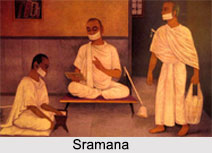 Sramana is one who believes that he himself is responsible for his self-eminence or decadence, happiness and sorrow, growth and decline. Thus the Sramana tradition inspires man to elevate himself by becoming self-reliant and self-exerting. Sramanacara is the code of conduct prescribed for Sadhu and Sadhvi in Jainism. "Sramana" is focus entity in Jain tradition. His spiritual discipline is the life-long vow of universal brotherhood.
Sramana is one who believes that he himself is responsible for his self-eminence or decadence, happiness and sorrow, growth and decline. Thus the Sramana tradition inspires man to elevate himself by becoming self-reliant and self-exerting. Sramanacara is the code of conduct prescribed for Sadhu and Sadhvi in Jainism. "Sramana" is focus entity in Jain tradition. His spiritual discipline is the life-long vow of universal brotherhood.
Preparations for Sramana Order
Before entering the Sadhu Sangha a householder needs to get initiated or take Diksha. The march from the stage of a house-holder to reach the stage of an ascetic involves complete detachment from mundane affairs and severance of all connections with the family, kith and kin, friends, etc. Now that one has renounced the world and entered the Sramana order, he/she needs to strictly observe the vows and austerities with full faith and utmost firmness. From morning to evening, the monks and nuns need to be engaged in different types of acts that are prescribed by the guru and scripture. They are not supposed to waste even a single minute carelessly. An ascetic has to have control over his passions and senses. He needs to make efforts for Samvara, Nirjara and observe penance and make it a point to observe the rules of conduct without any faults or transgressions.
Rules in Sramanacara
Amongst the numerous rules that need to be observed by a Sramana, here are some of the most important ones:
1. The Mahavratas (Five Great Vows): First of all he needs to strictly follow the five Mahavratas. These vows should be practiced through fivefold code of knowledge, perception, conduct, austerity and vigor.
2. The Samvar: In order to stop the influx of karmas-Samvar, he needs to observe 5 kinds of Samitis, 3 kinds of Guptis, 10 kinds of Yati Dharma, 12 kinds of Anupreksha and 5 kinds of Charitra or conduct.
Further, there are seven external observances that include; plucking of one"s own hair periodically, staying unclothed ( in some sects), keeping away from bathing, keeping away from cleansing of teeth, taking alms in the standing posture, taking only one meal a day preferably and sleeping on bare ground. Purpose of such acts is to avoid violence to other Jivas.
Six Essential Duties of Sramana
In addition to this, he has to observe the six essential duties known as the "Sadavasyaka" regularly. This is an indispensable obligatory duty that ought to be performed every day without failure. The Sadavasyaka that are to be observed by Sravakas are as follows:
1. Samayika: Samayika is a desire for liberation through self-control.
2. Chaturvimmsatistava: It is a devotional praise of the 24 Tirthankara to acquire their virtues.
3. Vandana: It means offering of respectful ceremonial salutation to the Jina, deserving monks and nuns or the sacred scriptures.
4. Pratikramana: Pratikramana or repentance is a ritual where one confesses for one"s wrong doings. It is a very essential rite that leads to purification and perfection.
5. Kayotsarga: Kayotsarga or meditation is bodily detachment. It helps in shedding of karmas.
6. Pratyakhyana: Pratyakhyana or renunciation is refraining from commission of sins in the future.
Daily Activities of Sramana
A Sramana"s daily activities mainly include:
1. Paddilehan - Scanning of his requisites
2. Swadhyaya - Study of self
3. Aloyana - Confession of faults
4. Gochari - Collecting alms
5. Pratikramana - Condemnations of transgressions
Thus, a Sramana is supposed to focus his activities primarily on purification of soul and avoid all sorts of violence. He is also supposed to guide and motivate lay persons to follow path of liberation but must avoid any action which can develop attachment with any individual or possessions.









